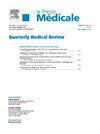癌症患者静脉血栓栓塞性疾病的预防和治疗。
IF 3.4
3区 医学
Q1 MEDICINE, GENERAL & INTERNAL
引用次数: 0
摘要
癌症相关静脉血栓栓塞症(CAT)在癌症患者中很常见,并与严重的发病率和死亡率相关。癌症相关静脉血栓栓塞(CAT)的发病率持续上升,使患者护理变得更加复杂,也加重了医疗保健系统的负担。发生 VTE 的癌症患者预后较差,因此预防和有效管理势在必行。这篇叙述性综述综合了接受系统治疗的非卧床癌症患者血栓预防措施和 CAT 急性治疗策略的相关证据。风险评估模型(如霍拉纳评分)有助于识别可能受益于血栓预防的高危患者。使用低分子量肝素(LMWHs)直接口服抗凝剂(DOACs)进行药物血栓预防已被证明可降低 CAT 的风险,同时不会显著增加出血并发症的风险。然而,基于风险的策略在临床实践中的实施仍然有限。在急性 CAT 的治疗中,LMWHs 一直是治疗标准,但 DOACs 因其方便和有效而越来越受到青睐。然而,挑战依然存在,包括出血风险和药物相互作用。以因子 XI 抑制剂为靶点的新兴疗法是很有前景的替代疗法,有可能解决目前 CAT 抗凝治疗的局限性。本文章由计算机程序翻译,如有差异,请以英文原文为准。
Preventative and curative treatment of venous thromboembolic disease in cancer patients
Cancer-associated venous thromboembolism (CAT) is common in patients with cancer and associated with significant morbidity and mortality. The incidence of CAT continues to rise, complicating patient care and burdening healthcare systems. Patients with cancer experiencing VTE face poorer prognoses, making prevention and effective management imperative. This narrative review synthesizes evidence on thromboprophylaxis in ambulatory patients with cancer receiving systemic therapy and acute treatment strategies for CAT. Risk assessment models (e.g., Khorana score) aid in identifying high-risk patients who may benefit from thromboprophylaxis. Pharmacological thromboprophylaxis with low molecular weight heparins (LMWHs) and direct oral anticoagulants (DOACs) has been shown to reduce the risk of CAT without significantly increasing the risk of bleeding complications. However, implementation of risk-based strategies remains limited in clinical practice. For acute CAT management, LMWHs have been the standard of care, but DOACs are increasingly favored due to their convenience and efficacy. However, challenges persist, including bleeding risks and drug interactions. Emerging therapies targeting Factor XI inhibitors present promising alternatives, potentially addressing current limitations in anticoagulation management for CAT.
求助全文
通过发布文献求助,成功后即可免费获取论文全文。
去求助
来源期刊

Presse Medicale
医学-医学:内科
自引率
3.70%
发文量
40
审稿时长
43 days
期刊介绍:
Seule revue médicale "généraliste" de haut niveau, La Presse Médicale est l''équivalent francophone des grandes revues anglosaxonnes de publication et de formation continue.
A raison d''un numéro par mois, La Presse Médicale vous offre une double approche éditoriale :
- des publications originales (articles originaux, revues systématiques, cas cliniques) soumises à double expertise, portant sur les avancées médicales les plus récentes ;
- une partie orientée vers la FMC, vous propose une mise à jour permanente et de haut niveau de vos connaissances, sous forme de dossiers thématiques et de mises au point dans les principales spécialités médicales, pour vous aider à optimiser votre formation.
 求助内容:
求助内容: 应助结果提醒方式:
应助结果提醒方式:


